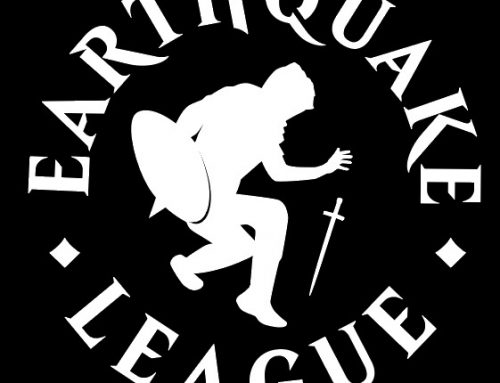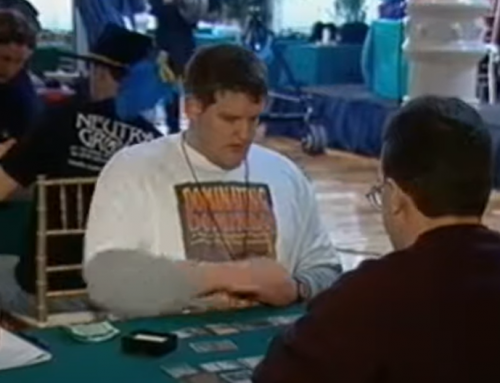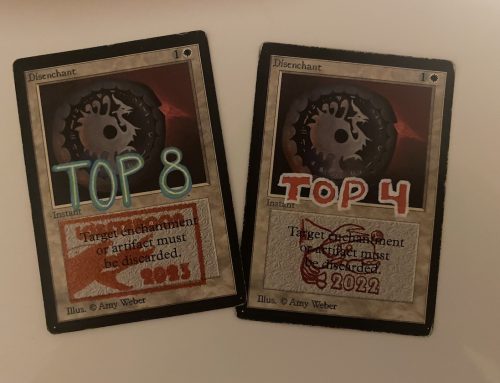If you’ve ever been to Buenos Aires, you might have noticed the contrast between the neighborhoods of La Boca and Belgrano. La Boca is a hectic, working-class neighborhood with colorful buildings, live street-tango performances, and small restaurants which are filled with locals and tourists. Belgrano is a mostly upscale neighborhood with high-rise apartment buildings, parks, specialty shops, and boutiques. It even has its own Chinatown. It’s a nice, calm place.

Belgrano, Buenos Aires – Argentina

La Boca, Buenos Aires – Argentina
What you probably don’t know about these two neighborhoods is that they are home to one of the greatest rivalries in the history of sport: the Argentinean Superclásico.
The Argentinean Superclásico is a football match played between the teams of Boca Juniors and River Plate. Both clubs have been slugging it out since 1913, and have played almost 250 times. The fans are so crazy that they would literally do anything for their team. Every game is jam-packed. The fandom and sheer insanity surrounding the event reached its apex in 2018, when both teams met at the finals of the Copa Libertadores, an international tournament for South America’s top teams. The first leg of the finals was tied 2-2. While on their way to the second game, the bus carrying the Boca Juniors team was mobbed by River Plate fans. They smashed its windows and pepper-sprayed the passengers, injuring several players. The match had to be rescheduled twice. The Argentinean fans were so insane that the tournament organizers decided to host the second leg in another continent, being played before 72,000 people in the Real Madrid’s Santiago Bernabeu Stadium in Spain.

Superclasico, Buenos Aires – Argentina
Lifelong rivalries in sports make the actual games so much more interesting: Stakes are higher, emotions are stronger, and the desire to defeat an ancient foe leads to some high-level plays and some horrible mistakes. I know that this also applies to Magic: the Gathering, because this is what happens whenever Team Dinero plays Team X-Optimo on the other side of the Andes.
Back in the early days of Chilean Magic, both teams dominated the local tournament scene. Like Boca Juniors, Team X-Optimo fancied themselves as working-class warriors; while Team Dinero —as with River Plate— was viewed as rich kids who had all the cards and came down to the tournaments to ruin everyone else’s fun; hence the team’s name. Competition between both teams was fierce.
More than twenty years have passed since we first opened our first starter packs, and members of both teams have become very close friends. However, whenever we get together to play Magic, the old rivalry reignites like a flame and each team does their level best to win.
Fast-forward to late 2019, Team Dinero’s members were slapped in the face in a group chat with this challenge:

Team Dinero was quick to pick up the glove. A mere 5,000 whatsapp messages later, the ground rules were established.
The Rules
The format of choice for this event was Old School Four (OS4). Never heard of it? Don’t worry, it was specially invented for the occasion.
The rules for OS4 are the following:
- Each team is composed by four players.
- Each player has to play with a deck of no less than 60 cards and a 15-card sideboard.
- The Eternal Central B&R list applies.
- Each team is unified, but can share cards.
- The tournament has four rounds, and was played on a team round-robin basis. Therefore, each player plays against each player of the opposing team.
- Each match won by a player earned his team 1 point.
- At the end of the fourth round, the team with the most points won. If there was a tie, a final round would be played, and if that one also ended in a tie, each team would choose a member to represent them in a Chaos Orb flip-off.
Team Dinero’s Deckbuilding Process
Both teams quickly realized that OS4 presented various challenges in terms of deckbuilding. Making four good decks in unified old school is a bit harder than three when you are building from a card pool with such a small size and power disparity as the one available in old school 93/94. Also, the team round-robin structure disincentivized strategies involving a garbage deck and three significantly stronger builds. This meant that creativity, flexibility and teamwork would pay big dividends. Many key decisions had to be answered, such as power distribution, use of duals, where to best assign utility lands, etc. What is interesting about this challenge is that both teams approached the task in somewhat similar way, but with big differences in some key aspects, and the result of the deckbuilding process surprised everyone.
Team Dinero’s approach to the format followed the following process:
- The first thing that Team Dinero did was look at the lands. The conclusion was that the mana base was not robust enough to support various multicolor decks because all of them would want to play City of Brass and as many dual lands as possible, and there was simply not enough to share around. Therefore, duals and cities were not given a high premium. This meant that mono-color decks would be preferred, and fancy splashes should be avoided, at least in the early stages of deckbuilding.
- When it came to fast mana, the strongest unrestricted cards were believed to be Dark Ritual and Mishra’s Workshop. Black’s greedy casting costs and Mishra’s drawback meant that each of these cards were to be the foundations for the first decks.
- From this point, the Dark Ritual deck almost automatically became a mono black midrange build. There was some discussion as to whether it was a good idea to splash blue for power and Serendibs or white for Swords to Plowshares and Disenchant, but was later deemed that a black was strong to scratch its own back and go full mono color. This would free up options for the other three decks.
- The Mishra’s Workshop build soon became a robot deck, so it was quickly filled with Su- Chi’s, Triskelions, and Tetravus. Mana Vault and Icy Manipulator naturally followed. Once the artifact core of the deck was in place, they needed to decide which would be its base color. Blue seemed to be the natural choice, since Copy Artifact would provide redundancy. Delving into blue also meant that Psionic Blast could be used as a flexible removal spell or finisher. Sage of Lat-Nam was also considered, since it could gobble up tapped Mana Vaults, spent Triskelions, and Tetravite tokens for additional cards, but was later discarded.
- Blue and white had enough cards available to build a control deck based on Counterspell, Swords to Plowshares and Moat. The third deck was quickly set up to be something very similar to the one that was used by Jon Finkel in Mobstercon 2019. It won with Millstone and had various interesting synergies with Field of Dreams, Sylvan Library, Land Tax and Millstone in order to gain card advantage, a ton of life, and lock the opponent out from drawing any relevant spells.
- The core of the last deck had to be red and green. Team Dinero initially dabbled with an RGU Tempo build with most of the free duals, Kird Ape, Erhnam Djinn, Serendib Efreeet, Psionic Blast and red burn were bundled up together. This choice was scrapped at the eleventh hour for a straight RG build with Atog, Black Vise, Ankh of Mishra, bolts, Erhnam Djinn and Berserk. The main goal of the deck was to pressure the opponent’s life total from multiple angles, and exploit the combination of Atog and Berserk to catch opponents by surprise.
- Once the core of the four decks were built, they proceeded to polish them. For the mono black deck, Team Dinero assumed that X-Optimo would also arrive with a workshop deck and a black-base deck, so traditional Terrors were swapped for Oubliettes and Paralyzes. It also packed the four Strip Mines, since they combined well with Sinkhole and the general disruptive nature of the deck. A full set of Nevinyrral’s Disks went into the sideboard, as well as Glooms, and Hymn to Tourach for potential control decks. The blue-based Workshops deck got a black splash to play The Abyss as well as Serendib Efreets in the sideboard to deal with back-breaking artifact hosers. It also got a couple of Transmute Artifacts, so it could search for silver bullets such as City In a Bottle. The RG Atog deck got a pair of Avoid Fates to dodge Lightning Bolt and Swords to Plowshares, and managed to borrow the fourth Sylvan Library to have a fighting chance in the long game. The UWg Control’s sideboard was packed with artifact removal, and additional ways to beat the creature matchups.
- Regarding restricted cards, Team Dinero decided to distribute each Mox to the deck’s primary colors. The blue robots deck took Ancestral Recall, Time Walk, and Timetwister, as well as the Black Lotus, because it was believed that it benefited the most from explosive draws. The WUg Control deck took Mox Pearl, Braingeyser and Library of Alexandria, and the mono black deck took the Chaos Orb because it was the softest to artifacts and enchantments. RG Atog had access to Mox Ruby, Mox Emerald and Sol Ring to assist the explosive starts.
Team Dinero ended up submitting the following war machines:

Mono Black, piloted by Thomas Sutherland

Blue Robots, piloted by José Luis Capdevila
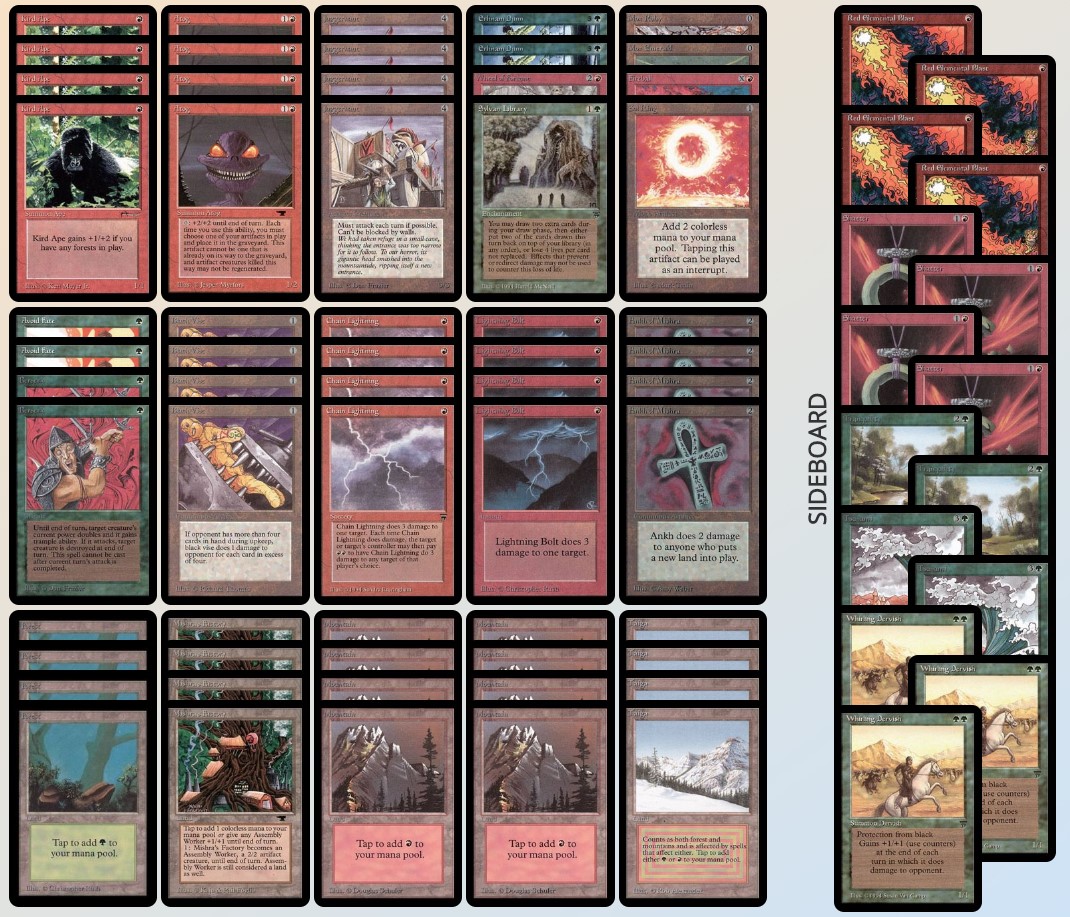
RG Atog, piloted by Luis Echeverría
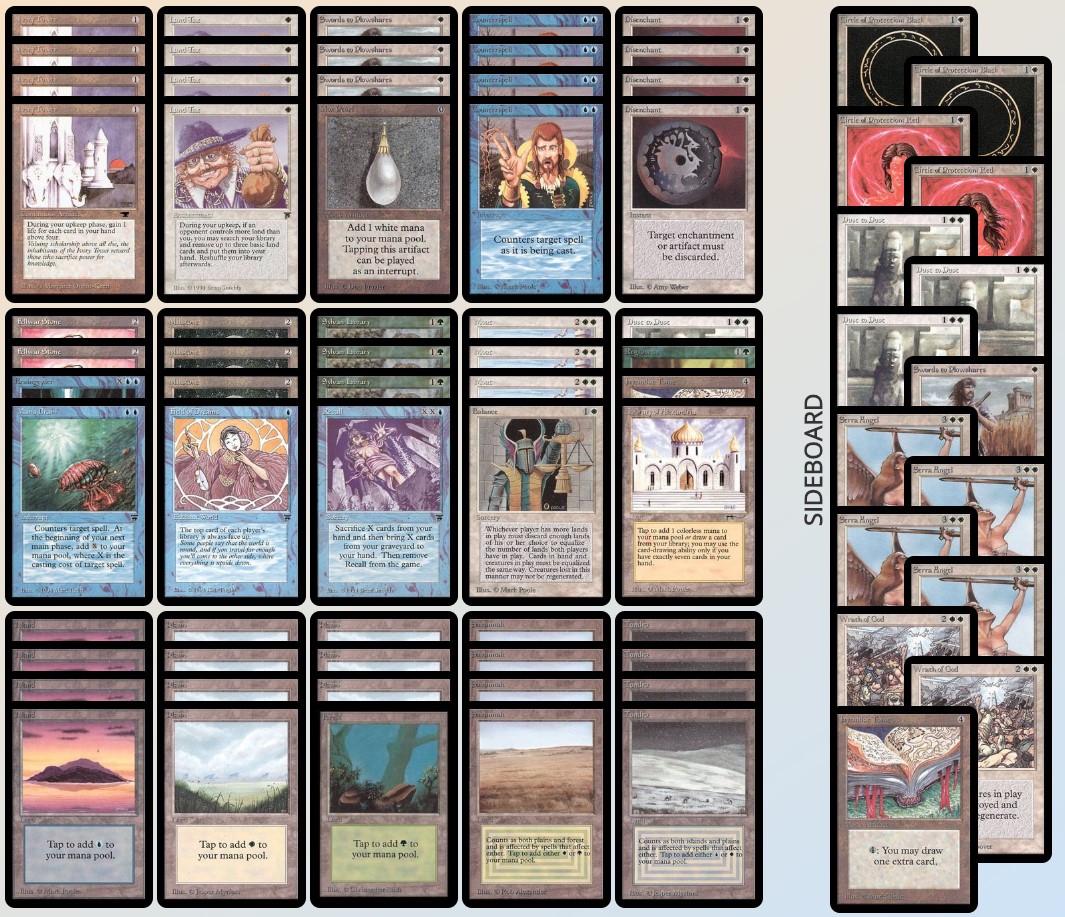
WUg Control, piloted by Ignacio Parot
Team X-Optimo’s Deckbuilding Process
Team X-Optimo also came up with a black-based deck, a Mishra’s Workshop deck, a green-based aggro deck, and a blue-white control deck; but to say that they arrived with similar decks than the opposing team would be a huge mistake.
X-Optimo’s deckbuilding strategy took the following route:
- Unlike Team Dinero, X-Optimo started from the basis that they wanted to use as much dual lands as possible. They ended up playing 32, doubling the amount played by their rivals.
- X-Optimo also determined that Mishra’s Workshop was a powerful, build-around mana accelerant, so they also decided to use an artifact-creature core; but diverged from their opposition by opting to slant the deck further towards aggression, pairing it up with red. This gave them access to Atog, Lightning Bolt and Chain Lightning. Playing with the smiley 1/2 and eight burn spells also made this deck a natural home for Black Vise and Ankh of Mishra. Strip Mine was also included to maximize the head start given by the explosive artifact mana.
- Dark Ritual was also used to build a black-based deck. While Team Dinero’s black deck was focused on gaining a tempo advantage with a land-destruction package, efficient removal and a heavy creature base, X-Optimo focused on discard, using full sets of Hymn To Tourach and The Rack, as well as a pair of Disrupting Scepters. Following their mandate to maximize the use of duals, they managed to cram in four Bayous, Badlands and Taigas. This allowed them to splash red for Fireballs and a Disintegrate; and green singletons Channel, Sylvan Library, Regrowth and Crumble; all of which could be fetched with Demonic Tutor. Havenwood Battleground was also added to ramp Channel for a faster kill.
- X-Optimo also wanted to play with a Counterspell-based control deck, and tinkered with various options, including versions with The Abyss and Moat. They had a breakthrough when they realized that they could use Spirit Link as a complement to Swords to Plowshares, which paved the road for white as the second color. They decided to use Mishra’s Factory as a wincon, so opted to go with a playset of Wraths of God as their sweeper of choice. Once they had the shell set up, they decided to add Plateaus and Volcanic Islands to splash a single Fireball in the maindeck and three Red Elemental Blasts in the sideboard.
- Once they established the core of the first three decks, they turned around to the remaining cards to see what they could assemble. The most evident choice was to build a green-white, creature-based deck, and in Old School that normally means Erhnamgeddon. Staying true to their multicolor strategy in order to maximize raw power, they threw in Tropical Islands and City of Brass to maximize the color-fixing potential of Birds of Paradise, and added Serendib Efreets and Psionic Blasts, as well as a full set of Energy Flux in the sideboard. X-Optimo’s version of the strategy dipped a little bit more into white than usual, sporting four White Knights and two Order of Leitbur.
- With the core of all four decks in place, they headed to the jewelry shop for some tuning and bling. Bantgeddon got to play with Mox Emerald, Black Lotus and Time Walk, while the control deck had access to Ancestral Recall, Braingeyser, Balance, and Library of Alexandria. In an interesting turn of events, they decided not to include Timetwister in any of their four decks. Because the control build was playing three copies of Red Elemental Blast, red robots grabbed had to settle for pair of Active Volcanoes to have a fighting chance against Energy Flux and other blue-based baddies.
This is what X-Optimo brought to battle:
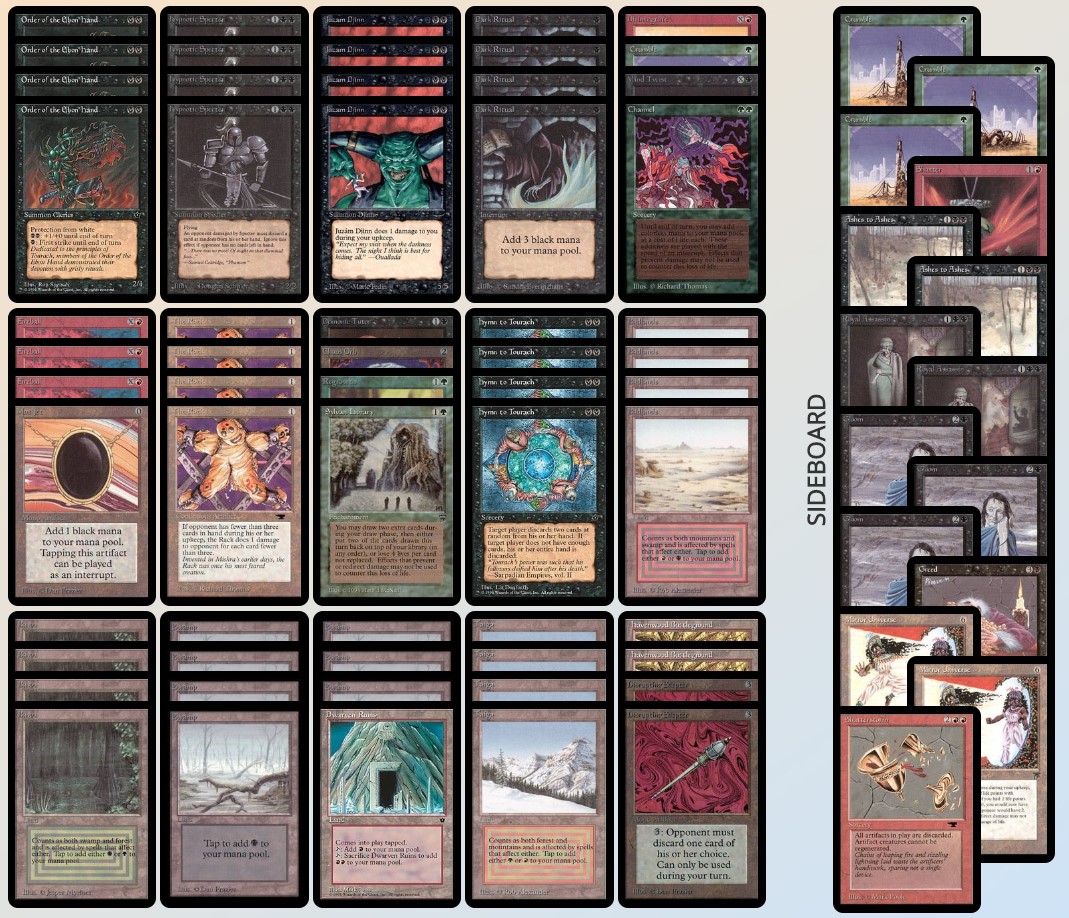
Jund, piloted by Andrés Hojman

Red Robots, piloted by Juan Reutter
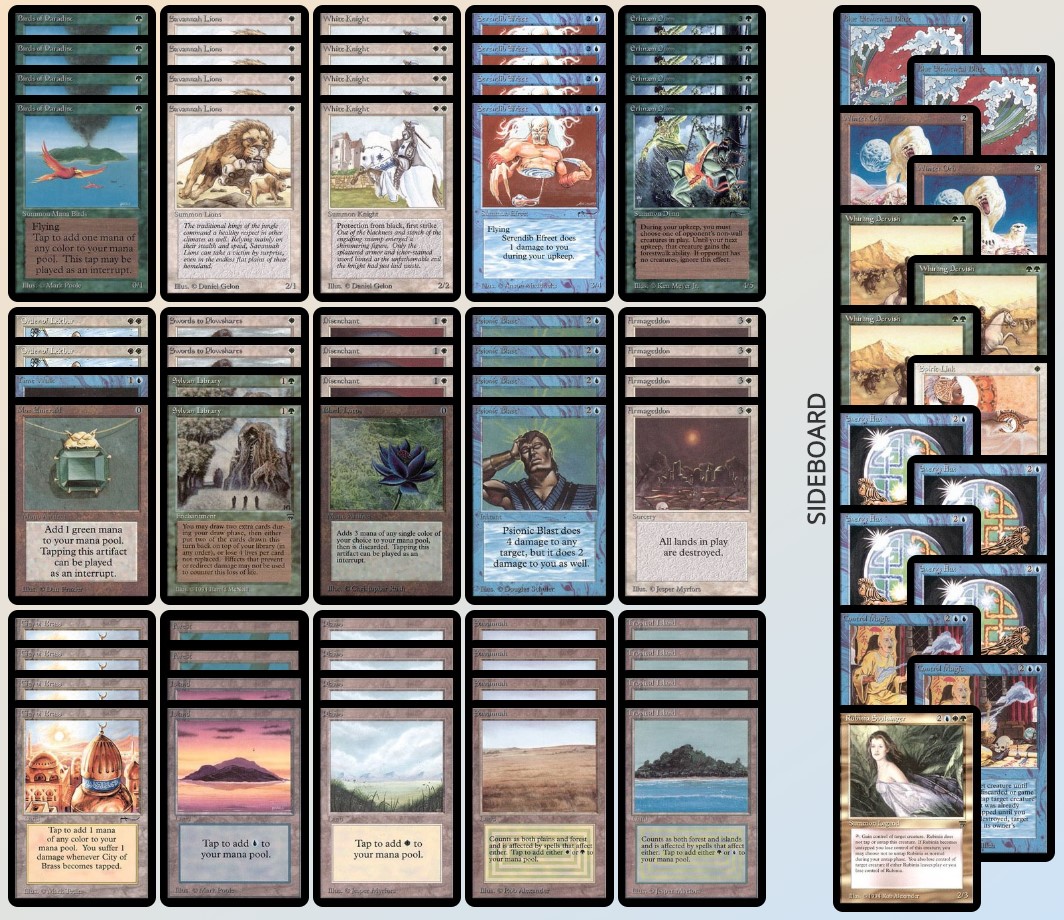
Bantgeddon, piloted by Emilio Ioannes

UWr Control, piloted by Rodrigo Sánchez
The day of the challenge was the hottest in the year, with a stifling 37 Celsius (98,6 Fahrenheit for our friends in the USA). Both teams agreed to meet after work at Ignacio’s apartment in downtown Santiago —ground zero for the recent protests that erupted last October—. In order to get there, the oldschoolers had to make their way through the ongoing clashes between projectile-throwing masked protesters and fully-armored riot police squads backed up by armored wagons with water-cannon turrets. Two members of Team Dinero had approached the city center in a Uber, and when they neared the battlefield in Plaza Italia the driver simply stopped the car and said something along the lines of “this is as far as I go”. As they approached the rendezvous point by foot, the combination of the scorching heat, tense atmosphere and sheer joy of getting to play old school Magic with lifelong friends and rivals provided all the ingredients for an upcoming superclásico.
The venue was as expected: spacious chairs and game space, with a fridge filled with beers and a bar with a fine selection of gins. Everything was set for the challenge to begin.
Round 1
Round 1 saw a clash of control decks between Parot and Sanchez. They played a single game, which lasted for the entire round. Both players engaged in a long war of attrition, which ended with Parot using three Millstones to, well… mill Sanchez’s Fireball — his only remaining wincon.
Hojman’s jund and Sutherland’s mono-black aggro decks battled it out. Hojman started things off with a turn 1 Hypnotic Specter, but it got Paralyzed on Sutherland’s first turn, who then proceeded to blow up a bunch of lands, from which Hojman was unable to recover. Sutherland also took over game 2 with an early Mind Twist for Hojman’s hand, and then played a couple of Juzám Djinns for the win.
Capdevila’s Blue Robots battled against de Ioannes’ bantgeddon. De Ioannes took over game 1 thanks to a mix of quick aggression and a timely Armageddon. Game two went long, but Capdevila managed to steal it by repeatedly tapping a City of Brass with an Icy Manipulator in order to ping de Ioannes to death. Game 3 was all for de Ioannes, who managed to play an early Energy Flux, Disenchant Capdevila’s The Abyss, Armageddon twice and then deploy multiple threats.
Reutter’s red robots deck overcame Echeverría’s RG Atog in three games. His bigger artifact creatures and efficient red removal managed to overcome Echeverría’s lower-to-the-ground strategy. The fact that Echeverría was color-screwed also didn’t help his efforts to win the match.
Dinero: 2 – X-Optimo 2.
Round 2
De Ioannes kicked Sutherland in the nuts. In game 1 he overpowered his opponent with a turn 1 land, Mox Emerald, double Birds of Paradise, which allowed him to play big creatures and run his opponent over. In game 2 Sutherland started with some initial pressure, but de Ioannes struck back with an Order of Leitbur and two Whirling Dervishes which allowed him to take the game without breaking a sweat, and their pro-black strategies paid them with a point.
Sanchez’s UWr had no problem dispatching Echeverrías RG Atog, which caught Team Dinero as a surprise because they thought that the matchup was quite favorable. In game 1 sanchez managed to pick apart Echeverría’s threats and control the board. In game two Echeverría was once again color-screwed, and could not play red spells until it was too late for him to mount a comeback.
This round also saw a battle of the robots between Capdevila and Reutter, who were wielding blue and red variants, respectively. In game one, Capdevila made the most of his Icy Manipulators and Copy Artifacts in order shift gears between defense and aggression, while Reutter’s burn spells were not efficient enough to close the gap. In game two, Capdevila managed to bring his opponent to single-digits, but Reutter managed to stabilize by burning some of Capdevila’s opposition and playing a Triskelion. Capdevila drew a Triskelion of his own and both of them stared at each other for a few turns until Capdevila topdecked a Black Lotus, and decided that he had sufficient open mana to cast a Timetwister and play his future hand. His new 7 brought him a bunch of goodies, including a Copy Artifact and a Psionic Blast, which allowed him to copy the Triskelion, and then go for the dome with 10 damage, taking the match.
In the last match of the Round, Parot’s UWg control deck was defeated by Hojman’s jund aggro deck. Hojman won the first game of the games by Channel-Fireballing his opponent out, and the second one by riding on the shoulders of Gloom and Hymn to Tourach.
Dinero: 3 – X-Optimo 5.
X-Optimo managed to secure a big advantage in round two. If they managed to pull the same feat in the next round, they would have forced Team Dinero to pull off a 4-0 in the fourth round, which seemed highly unlikely for the home team.
Round 3
Capdevila used the power of Mishra’s Workshop to accelerate huge robots that steamrolled Hojman’s creature-light, removal-light jund, whose Crumbles were not nearly enough to stop the brown beatdown from taking over the match in two swift games.
The robot strategy also found success on the other side of the trenches, netting Reutter a victory over Parot’s UWg Control build, who could not find enough lands to mount a timely defense.
Meanwhile, Sutherland’s mono black midrange faced Sanchez’s UWr control. Sanchez easily took game 1 by spirit-linking Sutherland’s turn-two Juzám Djinn, and then dealing with some of his smaller creatures. In game 2, Sanchez suffered a headache caused by a turn 1 Hymn to Tourach that snagged away a Counterspell and an Ancestral Recall, but bounced back by gaining over 20 points of life from an Ivory Tower. However, he was unable to play his spells thanks to a Gloom and a myriad of land destruction effects; eventually succumbing to his opponent’s creatures. In game 3 Sutherland again managed to nail Sanchez to the cross with a combination of multiple Glooms and Sinkholes, while riding a slew of knights and Hypnotic Specters for the win.
In the final match of the round, Echeverría’s RG Atog faced de Ioannes’s Bantgeddon deck. Echeverría won the first game by racing de Ioannes and using a Berserk as removal. The second game was for de Ioannes, who stole a key creature with a Control Magic and then neutralizing his opponent’s large Fireball with a Blue Elemental Blast. Echeverría stole the decider by staying slightly ahead in the race, while going for lethal with a unassuming attack with the help of a surprise Berserk and a Psionic Blast.
Dinero: 6 – X-Optimo 6.
Team Dinero had managed to claw back from an ugly loss in the previous round and were able to even the score before the final leg of the team round-robin. They were particularly happy with RG Atog’s win over Bantgeddon, which seemed a difficult matchup. They did lament the fact that their UWg Control lost vs to Red Robots, since it appeared to be a favorable matchup, especially after sideboard.
The consensus within Team Dinero was that Blue Robots has an almost impossible matchup vs UWr control and mono black was an underdog to the Red Robots’ mix of bigger, faster threats and cheap removal, which included two copies of Earthquake. RG Atog appeared to have the upper hand against jund, mostly because it had a better threat pool; and the UWg Control vs Bantgeddon would be a coin-flip.
Round 4
In the final round, Sanchez’s UWr Control deck had no problem in sending Capdevila’s blue robots to the scrapyard. Whatever creatures Capdevila managed to resolve in game 1 were quickly dealt with, and once Sanchez’s Jayemdae Tome became active, it was game over. In game two Sanchez brought a bunch of Dust to Dusts, and that proved to be too hard for the robots to overcome.
Parot’s UWg control fell to de Ioannes’ Bantgeddon, whose full playsets of Armageddon and post-board Energy Fluxes did most of the heavy lifting.
Echeverría Also managed to take a win from Hojman’s jund. A berserked Atog managed to take the lead in game one, and post board Whirling Dervishes sealed the deal for Team Dinero.
Sutherland and Reutter had an epic match. In game one, the red robots came out guns blazing, and a couple of Su-Chis exerted too much pressure for the mono black deck to be able to mount a serviceable defense on time. In game two, Sutherland repaid Reutter in kind with a turn 1 Juzám Djinn, but Reutter was able to fight back with a turn 2 Juggernaut off a Mana Vault. both creatures traded in combat. Sutherland mounted a second wave of pressure with an army of knights and Specters, which were mowed down by a two Triskelion and burn spells, however, Sutherland’s deck continued to churn out gas, allowing him to blow up most of Reutter’s red mana sources and proceeded to go for the win with a pair of Orders of the Ebon Hand, while he clinged onto his last two remaining life points. In game 3 Reutter had a turbo-charged start with a turn one Mishra’s Workshop that tapped to deploy a Black Vise and Ankh of Mishra, a turn two Su-Chi and a Turn 3 Juggernaut. Sutherland’s first turns were equally fast-paced. On turn 1 he played a Hypnotic Specter off a Dark Ritual; on turn 2 he used his Demonic Tutor to fetch for his Mox Jet, which he used to Paralyze the 4/4 construct; and on turn 3 he proceeded to Oubliette the Juggernaut, while stripping the Workshop. At this point the Hypnotic Specter had depleted Reutter of his resources, and was eventually locked-out of the game by the constant discard, additional land-destruction effects and his own Ankh of Mishra until his life total slowly hammered down to zero.
Dinero: 8 – X-Optimo 8. After 4 rounds and 16 matches throughout six hours of playing, drinks, ranting, more drinking and hamburger munching, the team round-robin ended up in a tie.
Deck Performance
The performance of each deck is in the team round-robin is summarized below:
| Team Dinero | W/L | Team X-Optimo | W/L |
| Blue Robots | 2-2 | Red Robots | 2-2 |
| UWg Control | 1-3 | UWr Control | 2-2 |
| RG Atog | 2-2 | Bantgeddon | 3-1 |
| Mono Black | 3-1 | Jund | 1-3 |
| Total points | 8 | Total points | 8 |
The Finals
Given that the round robin portion of the tournament had ended at 1 am, both teams decided to annul the possibility of another tie and go into a Chaos Orb flip-off in the middle of the night (although Hojman had been practicing his flips for weeks and was stretching somewhere in the living room in order to get ready) and go with a team-trios final. Both teams asked if anyone wanted to step down, to which Capdevila and de Ioannes begrudgingly took a knee.
Once the six players had been determined, the matchups were assigned at random. The pairings were:
| Seat | Pairing |
| A | Echeverría (RG Atog) vs Sánchez (UWr Control) |
| B | Sutherland (Mono Black) vs Reutter (Red Robots) |
| C | Parot (UWg Control) vs Hojman (Jund) |
Reutter took the first win of the match. In game 1 he charred most of Sutherland’s creatures, and when his opponent managed to stabilize with removal and a Sengir Vampire, Juan played a Wheel of Fortune and aimed multiple bolts to his opponent’s face. In game two, Reutter also started with quick aggression and a City in a Bottle to prevent Sutherland from playing the three Juzám Djinn’s in his hand. Sutherland managed to play a Nevinyrral’s Disk, and use it next turn to wipe Reutter’s board and play a 5/5 evil genie. However, Reutter quickly responded by slamming his second City in a Bottle and later taking the match with an unanswered Su-Chi.
In seat C, Parot kept a risky one-lander, and paid the consequences when Hojman’s jund came gun’s blazing with Juzám Djinns and Hymn to Tourachs. In game two, Parot kept a much more serviceable 7 with multiple Ivory Tower’s and a Land Tax, but again was mana screwed, which was then worsened when his opponent played a pair of Glooms, preventing him from playing his sweepers to stop the beatdown, or Land Tax to dig himself from the sand trap.
X-OPTIMO WINS!
Both teams congratulated each other for the awesome time that they had and swore to have another challenge in 2020; and although Team Dinero had lost in their home turf, Magic -like football- always gives you a chance for revenge.
Conclusions
OS4 turned out to be an amazing format to play with friends. I highly encourage you to try it. The deckbuilding restrictions were a tricky hurdle to overcome, and forced teammates to collaborate during the design process. Also, the team round-robin portion of the format required all decks to have a fighting edge against the opposing team’s strategies, which meant that anticipating the other team’s deck choices proved to be critical when it came to fine-tuning the decks. Another aspect of the tournament which made it particularly fun was that as players finished their matches, they went on to assist their teammates who were still fighting through the round. Finally, OS4 encouraged both teams to consider more obscure cards in the old school pool, which was really cool.
As for the actual decks that were brought to battle, it seems that both teams correctly identified the right macro archetypes for the format; but X-Optimo had slightly better decklists, and this ended up giving them an edge. However, every deck had its own set of hits and misses.
X-Optimo’s jund had a bunch of cool tricks up its sleeve, like being able to Channel-Fireball his opponent, and being able to splash green for artifact removal; however, in order to do so it had to use a horrible mana base, supporting only 16 black mana sources to service 16 double-black spells. It also supported little red mana to play its red X-spells, which were its only source of removal, and a clunky one at that. Jund was simply too clever for its own good, and was later described as an “overengineered” 75 which unsurprisingly racked up only one point during the team round-robin portion of the challenge. Team Dinero’s mono black deck was the exact opposite. It played no fancy ticks, and just focused to get ahead on tempo with a solid land destruction package, and a broader creature base. The otherwise unplayable removal package of Paralyze and Oubliette proved to be excellent, and helped it to collect three points.
Although both Mishra’s Workshop decks achieved a 2-2 result, it appears that the red version was better built than its blue counterpart. Like jund, Team Dinero’s version of robots also ended up being too cute by trying out Transmute Artifact and a small package of silver bullets, which turned out to be very disappointing; as did the Winter Orb lock plan. X-Optimo’s build on the other hand was sleek and full of aggression. On the flip side, some criticized the red build as being “neither here nor there”, because the burn package did not provide synergies with the large artifact creatures. Despite this, players on both sides of the fence hailed red robots as one of the best decks in the challenge.
Both control builds ended up with mediocre results, netting only 3 points between the both of them. Team Dinero’s build seemed better on paper, and was backed up by a winning performance in a prior team event; but did not manage to rack up a solid result for reasons that elude us. X-Optimo’s deck was more of a classic control build, but Wrath of God did not appear to be a solid way to deal with creatures, especially since it used Serra Angel as one of its wincons; and it was particularly weak to Gloom, which ended up being relevant. A possible alternative would have been to swap the red splash for black (they were not using either Scrublands nor Underground Seas) and add a mix of The Abyss and Moats, and replace the Serra Angels with a pair of The Hive.
Surprisingly, the green- based decks were the ones that had the best combined result, with five points. Team Dinero’s RG Atog deck was similar to the red workshops deck, but ended up being less synergistic than its red counterpart on the other side of the table. Its mana base was also off, playing fewer red sources than it should. In a post-challenge discussion, RG Atog was described as “a trap”. X- Optimo’s bantgeddon stood on the shoulders of Birds of Paradise, Serendib Efreet and Energy Flux to be one of the two highest performing decks of the evening, and was considered the revelation of the tournament. However, the six knights seemed too excessive for its mana base, and were normally played as a three-drop.
I hope you enjoyed this rather long piece about a bunch of friends playing old school. I do hope it motivates you to try OS4, since it was completely awesome.


